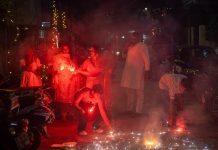
Thick smog blanketed India’s capital on Tuesday (Oct 21), the morning after Diwali celebrations filled the night sky with fireworks, pushing air pollution in New Delhi to hazardous levels.
Despite restrictions, revelers across the city set off firecrackers late into Monday night, adding clouds of smoke and fine particulate matter to the already polluted air. The mix of post-festivity emissions, seasonal crop-burning haze, and stagnant weather conditions trapped pollutants close to the ground.
By early Tuesday, the city’s Air Quality Index (AQI) had surged past 350 in several neighborhoods—categorised as “severe” and dangerous to breathe. Health experts warned that exposure at such levels far exceeds the World Health Organization’s daily recommended limit and poses serious respiratory risks, especially for children and the elderly.
Toxic air in India’s capital hit more than 56 times the UN health limit early Tuesday, after fireworks for the Hindu festival of Diwali worsened air pollution, reports AFP.
The Supreme Court, the nation’s top court. last week eased a blanket ban on firecrackers in New Delhi during Diwali, allowing limited use of “green firecrackers” that emit fewer pollutants. Developed by federal research institutes, they are designed to cut particulate and gas emissions by about 30 per cent. The court had said they could be used during specific hours from Saturday to Tuesday, but like past years the rule was mostly flouted.

New Delhi and its metropolitan region – home to more than 30 million people – routinely ranks among the world’s most polluted cities during the winter months when widespread Diwali fireworks coincide with cooler weather and smoke from crop residue fires set by farmers in nearby states, reported AP.
Delhi now has the dubious honour of being the world’s most polluted capital or capital territory for six consecutive years, according to the annual World Air Quality Report by Swiss air quality monitoring firm IQAir, reported CNA.
In November, the city’s Air Quality Index (AQI) soared to 795, almost eight times the threshold value of 100, when air quality becomes unhealthy. In some areas, the AQI even reached 1,185.
RELATED STORY:
80% Malwa belt groundwater ‘unfit’ for drinking – Report (Asia Samachar, 5 March 2022)
ASIA SAMACHAR is an online newspaper for Sikhs / Punjabis in Southeast Asia and beyond. You can leave your comments at our website, Facebook, Twitter, and Instagram. We will delete comments we deem offensive or potentially libelous. You can reach us via WhatsApp +6017-335-1399 or email: asia.samachar@gmail.com. For obituary announcements, click here































